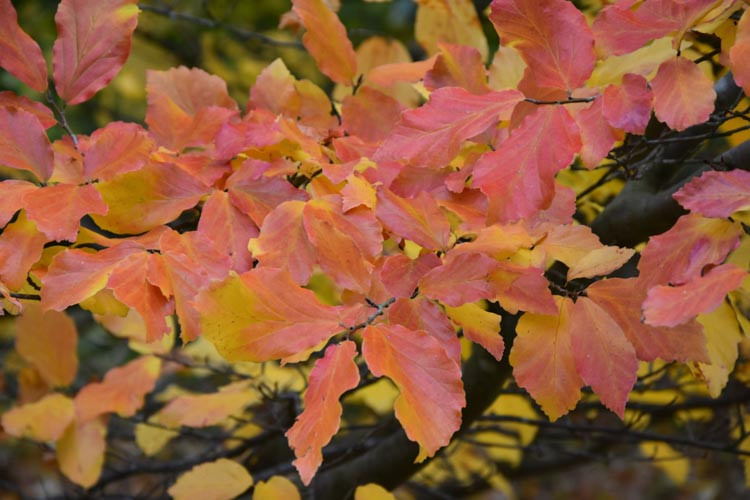Parrotia persica ‘Vanessa’, commonly called Vanessa Persian ironwood or Persian parrotia, is a stunning ornamental tree gaining popularity for its year-round interest and stellar fall color. As a medium-sized, upright deciduous tree that typically reaches 20-40’ tall by 15-30’ wide, it’s an excellent choice for many landscapes. This article provides an in-depth look at ‘Vanessa’ Persian ironwood, covering its key features, growing requirements, and uses in residential and commercial settings.
Overview
Parrotia persica is native to the Alborz mountains of northern Iran. The species was introduced to Europe and North America in the mid-1800s, with the ‘Vanessa’ cultivar emerging later as an improved selection. Compared to the straight species, ‘Vanessa’ Persian ironwood offers faster growth, better urban tolerance, and more vibrant fall color.
This compact, deciduous tree has a narrowly upright, pyramidal form with strong horizontal branching tiers. It exhibits a medium growth rate of 1-2′ per year. Mature dimensions of 20-40’ tall x 15-30’ wide make it well-suited to many landscape uses. ‘Vanessa’ adapts readily to various sites but does best in moist, well-drained, acidic soil and full sun to partial shade.
Ornamental Features
Beyond its excellent habit ‘Vanessa’ parrotia provides multi-season interest
-
Winter – Exfoliating bark in patches of cream, gray, green, amber and brown creates a beautiful patchwork pattern on mature trunks and branches.
-
Spring – Clusters of tiny but showy deep red flowers bloom as the leaves emerge, each with a bright red center.
-
Summer – Glossy green, 4-6” wide oval leaves have a nice serrated edge Foliage contrasts nicely against the patchy bark.
-
Fall – Foliage transforms to brilliant shades of yellow, orange and red for several weeks of color. Intensity increases with sun exposure.
Growing Requirements
-
Hardiness Zones – Zone 5 to 8
-
Sun – Full sun to partial shade
-
Soil – Moist, well-drained, acidic soil. Tolerates clay, loam, sand, gravelly or rocky soil.
-
pH – Acidic to neutral
-
Watering – Moderate watering needs. Requires occasional irrigation during drought.
-
Maintenance – Easy care once established. Little pruning needed beyond removing dead branches.
Landscape Uses
Thanks to its compact size, ornamental traits, and urban tolerance, ‘Vanessa’ parrotia has many potential uses:
-
Specimen tree – Its year-round beauty makes it perfect for planting alone as a focal point.
-
Accent tree – Provides nice contrast against evergreen backdrops.
-
Street tree – Adds seasonal interest and fall color to street plantings.
-
Parks and public spaces – Provides multi-season appeal in low maintenance plantings.
-
Residential landscapes – Fits nicely into yards, positioning it near entries, corners or patios to admire its features.
Buying Vanessa Persian Parrotia Trees
You can buy ‘Vanessa’ Persian ironwood trees from specialty nurseries and online sources. They are sold in containers or balled and burlapped. Be sure to give them adequate space to reach full mature size for maximum impact. Properly sited, this stellar specimen tree will provide lasting beauty and appeal in your landscape.

Additional InformationVanessa is a cultivar that has a distinctly upright or columnar habit. One of the best trees for foliage and bark effect. Very adaptable, tolerating drought, various soils, heat, cold, etc. Prefers full sun but tolerates light shade. Sites with strong winter winds will surely cause tip dieback in Northern Indiana.
| Number | Accession ID | Location |
| 1 | 2015_00876*A | CQS |
| 2 | 2015_00875*A | SC |
Parrotia persica (Persian ironwood)- All you need to know about this Autumn beauty
FAQ
How big do Parrotia persica Vanessa get?
| Hardiness | 4 – 7 What’s My Zone? |
|---|---|
| Height | 15′ – 40′ (4.6m – 12.2m) |
| Spread | 10′ – 20′ (3m – 6.1m) |
| Maintenance | Low |
| Water Needs | Average |
Are Persian ironwood trees messy?
It’s also not a messy tree and not a rampant rooter, so it’s a good choice for a little shade near a deck, patio or water garden. As a multi-stem tall shrub, parrotia is good for borders and for spotting on banks.
How tall does a Parrotia persica get?
Parrotia persica, commonly called Persian ironwood, is a small to medium sized, single trunk, deciduous tree eventually growing 20-40′ tall (but typically 10′ after 7-8 years) or a large, multi-stemmed shrub growing to 15′ tall.
How do you care for a Parrotia tree?
Water your Parrotia persica tree regularly, keeping the soil moist but not wet. Provide mulch around the tree’s base to retain moisture and reduce weeds. Fertilize once a year in the spring with a balanced fertilizer. Make sure to prune the tree regularly to keep it healthy and to look its best.
